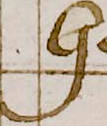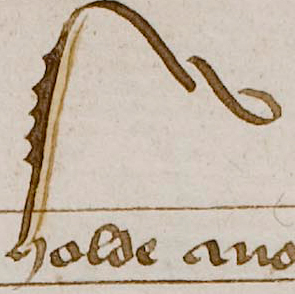|
| A |
 | Usage: a
an oval-shaped lobe to single compartment 'a'. |  | Usage: Axe
the scribe occasionally uses an upper case 'A' for some words within the text. |
 | Usage: And |  | Usage: alios
from the Latin gloss in the margin of f78v. |
|
| D |
 | Usage: wolde
unlooped 'd' used throughout. |  | Usage: armed
'd' in final position with tag. |
 | Usage: and
the two strokes which go to make up the scribe's 'd' may be seen clearly in this example. | | |
|
| G |
 | Usage: fight
characteristic tailed 'g' of this scribe with short, straight tail-stroke |  | Usage: legges
a slight left-ward inclination on the descender |
 | Usage: high
the lobe of 'g' is often very small. |  | Usage: maryage
'g' with more pronounced curve to the tail. |
|
| H |
 | Usage: her
the usual presentation of 'h'. It is a squat graph with head-loop and short limb. |  | Usage: Howe
'H' as the first letter of the last line of text and the scribe continues the tail-stroke of the letter into the ruled parallel lines of the left margin. |
 | Usage: sight
in the scribe's crossed 'h', the horizontal line usually just grazes the top of the letter. |  | Usage: holde
'h' on the top line with exaggerated ascender extending into the space. |
|
| R |
 | Usage: euery
modern 'r' used extensively. The stem descends at an angle. The shoulder is detached. |  | Usage: brode
'z'-shaped 'r' used after 'o' and some consonants. |
 | Usage: harde
the scribe rarely uses long 'r'. The fork, such as it is, is close to the top of the initial stroke. |  | Usage: Rome
upper case 'R' with arched approach stroke beginning below the body of the letter. |
|
| S |
 | Usage: p(ar)amouris
kidney-shaped 's' used in final positions. |  | Usage: Som
upper case 'S' at the beginning of a line. |
 | Usage: assembled
long 's' used in initial and medial positions. |  | Usage: sent
long 's' used in initial position with head-stroke arching over following graphs.. |
|
| W |
 | Usage: knowe
this form of 'w' with looped head occurs occasionally. |  | Usage: wolle
the form of 'w' with or without an approach stroke which is the most frequently used form of the letter. |
 | Usage: welle |  | Usage: was
a 'w' on the top line with strapwork decoration, a feature of some letters on the top lines of folios in this manuscript. |
|
| Y |
 | Usage: mayst
the tail of 'y' is usually straight. Here there is a slight flick to the right. |  | Usage: myght
the tail frequently extends back under several letters at a forty-five degree angle. |
 | Usage: Ye
an unusual upper case letter at the beginning of a line. |  | Usage: you
the same arched lead-in stroke as in the example of the upper case 'Y' though not so pronounced. |
|
| Upper Case Oddities |
 | Usage: Thy
the vertical line is the ruled margin line, not part of the distinctive circular 'T'. |  | Usage: Of
a curly stroke through the centre of the graph as decoration. |
 | Usage: Nowe |  | Usage: Custaunce |
|
| I |
 | Usage: I
upper case 'I' is distinctive with the appearance of a modern number 7. |  | Usage: Is |
 | Usage: Imprudent | | |








































